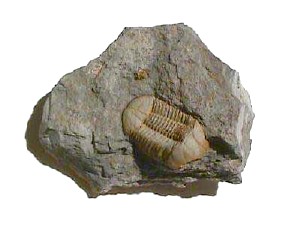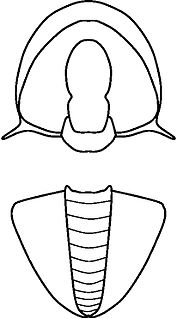
Paradoxides is a genus of large to very large trilobites found throughout the world during the Mid-Cambrian period. One record-breaking specimen of Paradoxides davidis is 37 cm (15 in). It has a semicircular head, free cheeks each ending with a long, narrow, recurved spine, and sickle-shaped eyes, providing almost 360° view, but only in the horizontal plane. Its elongated trunk was composed of 19-21 segments and was adorned with longish, recurved lateral spines. Its pygidium was comparatively small. Paradoxides is a characteristic Middle-Cambrian trilobite of the 'Atlantic' (Avalonian) fauna. Avalonian rocks were deposited near a small continent called Avalonia in the Paleozoic Iapetus Ocean. Avalonian beds are now in a narrow strip along the East Coast of North America, and in Europe.

Ductina is a genus of extinct, small to average sized, eyeless phacopid trilobite, that lived during the Devonian.

Dikelocephalus is a genus of very large trilobites of up to 50 cm (20 in) long, that lived during the last 3 million years of the Cambrian (Sunwaptan). Their fossils are commonly found as disarticulated sclerites, in the upper Mississippi Valley and in Canada (Alberta). The exoskeleton is rounded anteriorly, with the thorax and sides of the tailshield slightly tapering to about ⅔× of the width across the base of the spines at the back of the headshield. At the side corners of the pygidium there may be triangular or hooked spines, pointing backwards, while between the spines the posterior margin is at a 30-75° angle with the lateral margin, gently convex or nearly straight. If pygidial spines are lacking, the margin is gradually rounded. The thorax has 12 segments.

Acontheus is a genus belonging to the well-known extinct class of fossil marine arthropods, the trilobites. It lived during the Cambrian Period, which lasted from 541 to 485.4 million years ago. The genus is geographically widespread having been recorded from middle Cambrian strata in Sweden, Newfoundland, Germany, Siberia, Antarctica, Queensland, China and Wales.

Acidiscus is an extinct genus of eodiscinid agnostid trilobites. It lived during the Botomian stage of the Cambrian period.

Acimetopus is a genus of trilobites that lived during the Botomian stage.

Analox is an extinct genus of agnostid trilobite. It lived during the Botomian stage. It can easily be distinguished from other trilobites by the two furrows that extend forwards and sidewards from the front of the glabella.

Olenelloides armatus is an extinct, small sized olenelloid redlichiid trilobite arthropod. It lived during the later part of the Botomian stage, which lasted from approximately 524 to 518.5 million years ago. This faunal stage was part of the Cambrian Period. The most conspicuous feature is the hexagonal head shield that carries 6 ray-like spines..

Nephrolenellus is an extinct genus of trilobite, fossil marine arthropods, of relatively small size. Currently two species are attributed to it. Nephrolenellus lived at the end of the Lower Cambrian. Species are known from the Great Basin of California, Nevada and Arizona, with one specimen from Canada.

Peachella is an extinct genus of trilobites, fossil marine arthropods, with species of average size. It lived during the Toyonian stage, 516 to 513 million years ago, in what is today the southwestern United States. It can easily be distinguished from other trilobites by its club-like genal spines.

Biceratops is an extinct genus of olenelloid redlichiid trilobites, of average size, with the largest specimen 8 centimetres or 3.1 inches long, not including the huge pleural spines of the 3rd segment of the thorax. It lived during the Toyonian stage, in what is today the South-Western United States. Biceratops can easily be distinguished from other trilobites by the absence of genal spines, in combination with effaced features of the raised axial area of the head shield, that is bordering the two horn-like projections that carry the eyes. Biceratops nevadensis is the only known species in this genus.
Mesolenellus is an extinct genus of trilobites that lived during the lower Cambrian (Botomian), found in Greenland and Spitsbergen.

The Bristoliinae is an extinct subfamily of trilobites, fossil marine arthropods, with species of small to average size. Species belonging to this subfamily lived during the Botomian and Toyonian stage (Olenellus-zone), 522-513 million years ago, in the former continent of Laurentia, including what are today Mexico, the Appalachian Mountains and the south-western United States, and Canada.
Lochmanolenellus is an extinct genus of trilobites, fossil marine arthropods, with one small species, L. mexicana. It lived during the Botomian stage (Olenellus-zone), 522–513 million years ago, in the South-West of the former continent of Laurentia, in what are today Mexico, and the South-Western United States.

Bristolia is an extinct genus of trilobite, fossil marine arthropods, with eight or more small to average size species. It is common in and limited to the Lower Cambrian shelf deposits across the southwestern US, which constitutes part of the former paleocontinent of Laurentia.

Emigrantia is an extinct genus of trilobites, fossil marine arthropods, of small to average size. It lived during the Toyonian stage, in what is today the South-Western United States. Emigrantia can easily be distinguished from other trilobites by the sturdy but not inflated genal spines, that are attached at midlength of the cephalon, in combination with effaced features of the raised axial area of the head shield.
Bolbolenellus is an extinct genus of trilobites, fossil marine arthropods, with five species attributed to it currently. It can be easily distinguished from all other trilobites by the combination of the absence of dorsal sutures in the head shield like all Olenellina, and a distinctly bulbous frontal lobe (L4) of the raised axial area in the head called glabella. The species lived at the end of the Lower Cambrian.

Sphaeragnostus is an extinct genus from a well-known class of fossil marine arthropods, the trilobites. It can be recognized by having two thorax segments, a totally effaced headshield, while the tailshield although effaced, has a clear furrow parallel to its border, and a short, convex, subcircular axis. It lived during the Ordovician.

Geragnostus is a genus of very small agnostid trilobites whose fossils are found Ordovician-aged marine strata from Eurasia, North America and Argentina.
Tannudiscus is an extinct genus from a well-known class of fossil marine arthropods, the trilobites. It lived during the upper Lower Cambrian, with remains found in Canada (Newfoundland), China (Gansu), The United Kingdom (England), and the Russian Federation.















